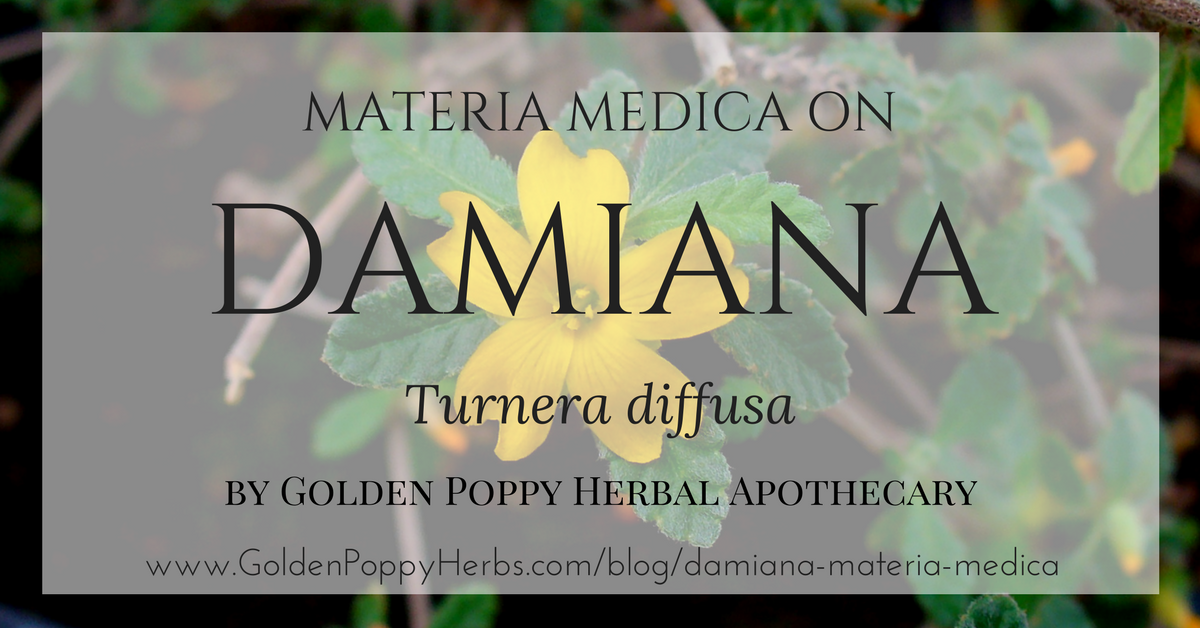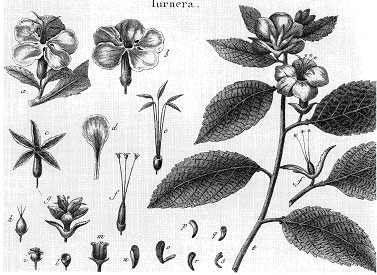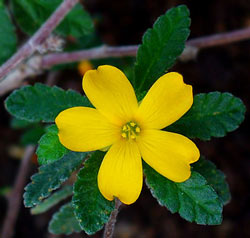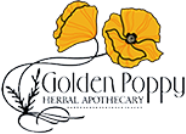 Damiana was beloved by the Aztecs and Mayans, used to treat impotency, increase sexual drive in both men and women, and stimulate the nervous system while promoting relaxation. Traditionally the fragrant leaves were brewed as a tea and sweetened with sugar or honey to stimulate lovemaking and is featured in Central American mystical folklore for its spiritual, feminine powers. It has also been used recreationally in liquor or smoking pipes, giving off a sweet fragrance and reducing anxiety. Damiana as a tea is a tonic for the kidneys, the sexual organs and the nervous system. It is excellent at balancing the hormones and the emotions and increasing blood flow to the pelvic region. The effect of this tea is definitely more noticeable when one is feeling down, out of sorts, grumpy, angry or upset, giving one a natural feeling of well-being.
Damiana was beloved by the Aztecs and Mayans, used to treat impotency, increase sexual drive in both men and women, and stimulate the nervous system while promoting relaxation. Traditionally the fragrant leaves were brewed as a tea and sweetened with sugar or honey to stimulate lovemaking and is featured in Central American mystical folklore for its spiritual, feminine powers. It has also been used recreationally in liquor or smoking pipes, giving off a sweet fragrance and reducing anxiety. Damiana as a tea is a tonic for the kidneys, the sexual organs and the nervous system. It is excellent at balancing the hormones and the emotions and increasing blood flow to the pelvic region. The effect of this tea is definitely more noticeable when one is feeling down, out of sorts, grumpy, angry or upset, giving one a natural feeling of well-being. 
https://www.amazing-nature.com/images/damiana2.jpg  http://www.rebeccasherbs.com/images/news/news_02_12_hom.jpg
http://www.rebeccasherbs.com/images/news/news_02_12_hom.jpg
 http://www.rebeccasherbs.com/images/news/news_02_12_hom.jpg
http://www.rebeccasherbs.com/images/news/news_02_12_hom.jpg
MATERIA MEDICA: DAMIANA
Latin Name: Turnera diffusa Family: Turnerceae Parts Used: Aboveground plant Energetics: Warm, dry, slightly bitter, aromatic, pungent, yang nourishing Botanical Description: Damiana is a small shrub with pale green, serrated, wedge-shaped leaves arranged alternately on a short, slender leafstalk. The small, 5-petaled yellow flowers grow in the leaf axils, and produce a small fruit whose taste is said to be reminiscent of fig. Actions: Damiana nourished yang, invigorates the brain and nerves, regulates the pituitary gland, and promotes physical endurance. The bitter principle stimulates the nerves and genitals and allows nerve messages to more readily spread throughout the body.- Anti-catarrhal
- Antidepressant
- Anti-inflammatory
- Anxiolytic
- Aphrodisiac
- Astringent
- Balances hormones
- Nervine
- Reproductive tonic
- Stimulant
- Diuretic
- Tea: 1 tsp damiana in 1 cup boiling water, steep 10-15 min, take 3x per day.*
- Tincture: 1 tsp per day. **
Dosage information from *Damiana: Herbal Medicine Materia Medica by David Hoffman and **Down There: Sexual and Reproductive Health by Susun Weed.
Key Constituents: Volatile oils, flavonoids, a bitter substance (damianin), tannins, flavonoids, and glycosides (Hoffman, n.d.).
Harvesting Guidelines: Damiana leaves and stems are harvested when the plant is in bloom.
Uses:
- Impotence
- Infertility
- Depression
- Low libido
- Stimulant
- Diuretic
- Urinary antiseptic
- Mars, Brigette. (2007). “The Desktop Guide to Herbal Medicine.” Basic Health Publications, Inc. Laguna Beach, CA.
- Skenderi, Gazmend. (2003). “Herbal Vade Mecum.” Herbacy Press. Rutherford, New Jersey.
- Boericke W (1988). Pocket Manual of Homoeopathic Materia Medica. New Delhi, India: B. Jain; 1988. Retrieve on October 8, 2014 from http://www.homeoint.org/books/boericmm/d/dam.htm.
- Ellingwood, (1919). The American Materia Medica. Retrieved on October 8, 2014 from http://www.swsbm.com/Ellingwoods/Ellingwoods_plants_only.pdf.
- Estrada-Reyes, KR, Ortiz-Lópeza, P, Gutiérrez-Ortíza, J, & Martínez-Mota, L (2009). Turnera diffusa Wild (Turneraceae) recovers sexual behavior in sexually exhausted males. J Ethnopharmacol. 2009 Jun 25;123(3):423-9.
- Hoffman, David (n.d.). Damiana: Herbal Medicine Materia Medica. Retrieved on October 8, 2014 from http://www.healthy.net/Materia_Medica/Damiana_Herbal_Materia_Medica/196.
- Kumar, S and Sharma, A (2005). Anti-anxiety Activity Studies on Homoeopathic Formulations of Turnera aphrodisiaca Ward. Evid Based Complement Alternat Med. 2005 Mar;2(1):117-119.



